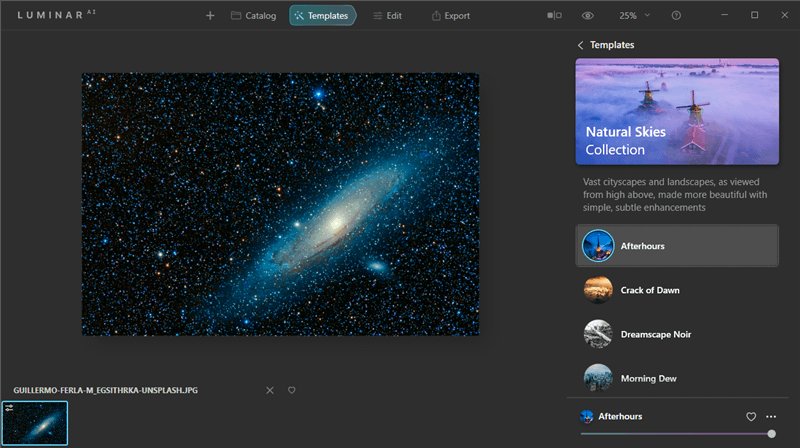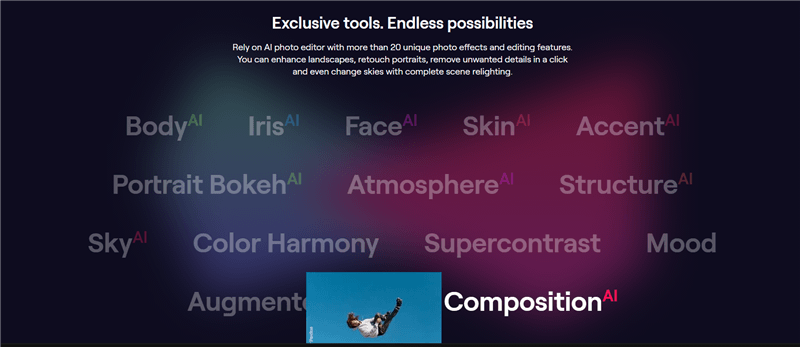The milky way is undoubtedly one of the most beautiful things to capture in the universe. It’s so flawlessly beautiful that it’s almost impossible to capture its beauty without reducing it, but this is only half the battle. It’s also important to make minor tweaks to your photograph to give it the perfect shot. This allows you to highlight the details better and enhance the color reduction caused by the quality your camera can produce. The goal is to ensure your photograph appears spectacular to the eye while retaining the natural look of the milky way. Achieving this has been difficult for astrophotographers, hence the introduction of Luminar AI.
About Luminar AI
According to the creators of this software, it is an image editor powered fully by AI. While there is other image editing software, such as Adobe Photoshop, that AI also powers, Luminar AI adds something different. This software seeks to reduce the time photographers spend editing images and make the process fun for them. This is something that many photographers (beginners and experts) struggle with at times.
Luminar AI allows you to edit your photographed images much better than before and opens you up to better realities. The simplest way to explain this app is that it works like Instagram filters, but it’s much more advanced, in-depth, and gives far better results. The software is results-based, giving the option of a one-click template that instantly transforms your image from boring to beautiful. However, it’s possible that you don’t like the results you get from the instant template use. In this case, you can self-edit using the templates.
The template system this software uses is interesting because it completely changes how your image feels in a fluid and creative way. Luminar may suggest preset filters that match your image based on the content type and the information it gathers from the data. This is where AI comes to play.

This system might often be hit and miss on your photography, especially when you use it on a deep-sky object image. You’re more likely to get a better success rate with nightscape images with natural foreground landscapes.
Astrophotography and Luminar AI
You may already have a comfortable routine for processing images and are experienced in processing software such as Adobe Photoshop, DeepSkyStacker, and other astrophotography stacking software. So, it’s understandable if you have doubts about this other software and its ability to work well on deep-sky astrophotography images.
Astrophotography is quite different from traditional photography or other types of photography. Most times, you have to become crafty in using software to give you the desired result. There are many out-of-box image editing tools that you can’t use when working on a long-exposure image of the sky at night.

It may also be hard to understand why you should bother with a tool that uses a one-click effect for editing (like an Instagram filter), especially as an astrophotographer and because of the kinds of images you have to edit.
However, you only need to try it out and see how it works. Once you see one or two examples of how this image editing tool works, you’ll agree that it’s one of the most powerful tools for astrophotographers, especially at the beginner and intermediate levels. It can also work well for experts looking to add creative finishing touches to their image editing.
Features of Luminar AI for Astrophotography
This tool has several features, but the Composition AI feature is one of the most effective features for nightscape photography. You will appreciate this tool more if you use it on a nightscape image with foreground interest within the frame. You can consider this feature similar to powered cropping, which suggests compositions created by the collaboration of professional photographers. This feature can fix simple issues such as alignment, perspective, and tilt.

If you go through the edit tab of this tool, you’ll find the detail, structure, and enhanced adjustments, all of which are important tools for deep-sky photographs. When you use this tool, you’ll find that they are enhanced by artificial intelligence and give incredible results.
The edit tab also has a creative section, which makes it quite interesting. It’s where you’ll find the Sky Replacement feature option live (called Sky AI).

Naturally, many astrophotographers wouldn’t want to replace the primary subjects of their image. But you can only find out how impressive the feature is if you try it out. For instance, you can use the sky replacement tool on a daytime image of your telescope to see how it works. It’s only then that it has impressive refinement and automatic masking tools. You don’t know this without the willingness to give it a try. This tool allows you to adjust different aspects of the fake sky (which you can choose from the preset option list). You can adjust the direction of the sunlight, the size, etc. A good example of this is in the image below. That’s what the tool looks like when put to work.
How to Use Luminar AI
The Luminar AI tool is available as a stand-alone tool and can work independently. However, you can also use it as a third-party tool, such as a plugin for other tools, such as Adobe Photoshop. If you decide to use it as a third-party tool, you can do much editing and processing with the other tool and use Luminar AI as the last step.

As the name implies, this tool is powered entirely by Artificial Intelligence to make the image-processing experience easier and faster. Machine Learning reads the image, and a template that matches the image is suggested for editing and where to add specific adjustments. You may not like adding elements that aren’t there to your images, but if you don’t mind, you can add preset skies, reflections, fog, and the like. However, you may not want to do this, being an astrophotographer.
Several features in Luminar AI are built for portrait photography (Body AI, Skin AI, etc.) and landscape photography. But if you’re also into other types of photography, they will have lots of fun editing them on Luminar AI. You can also use this software to edit your YouTube thumbnails to make them more attractive and eye-catching.

Conclusion
There is a lot to say about Luminar AI as an image editing tool for astrophotographers because it offers so much more than we can cover in one post. It’s worth trying out this tool. However, to use it effectively, you must be open to trying out the different features and understanding them better. The goal of this tool is to make editing faster and easier, but you need to learn how to master it first.
While already established image editing tools such as PixInsight and Photoshop exist, Luminar AI is worth the shot. It might only be able to replace them partially, but if you need a tool that allows you to show your flair and creativity, then you should go for it.

[…] AI-powered tool utilizes advanced algorithms to automatically analyze and align multiple images, resulting in a […]